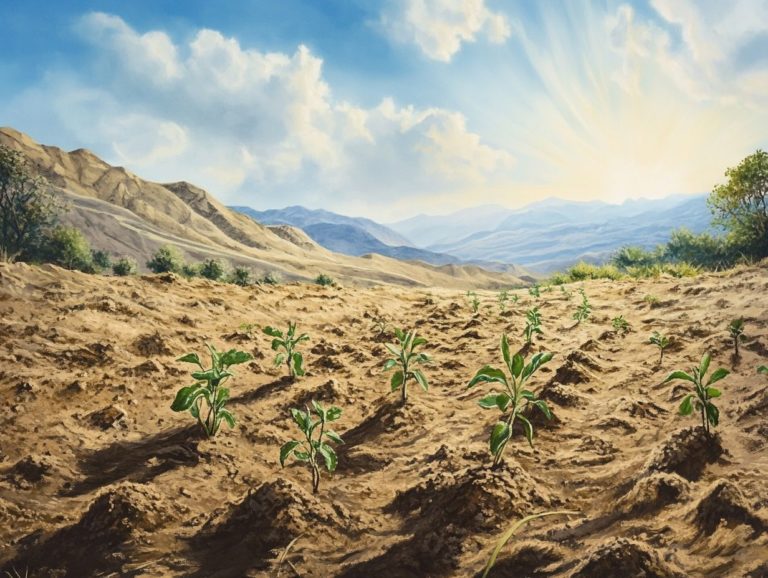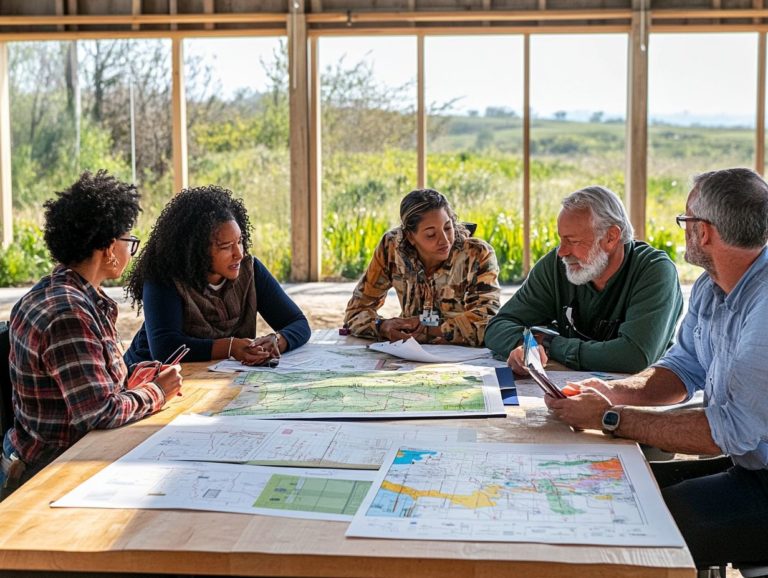How Soil Conservation Practices Benefit Ecosystems
Soil is frequently referred to as the very foundation of life. It serves a vital role in our ecosystems. As you navigate the growing environmental challenges of our time, recognizing the importance of soil conservation has become increasingly urgent!
This article explores how sustainable practices enhance soil health and fertility while safeguarding against erosion and nutrient loss. You ll discover various soil conservation methods, learn how to implement them effectively on farms, and understand their positive impacts on biodiversity and water quality.
Let s discover how nurturing our soil can create a healthier planet for everyone!
Contents
- Key Takeaways:
- The Importance of Soil Conservation
- Benefits of Soil Conservation Practices
- Types of Soil Conservation Practices
- Implementing Soil Conservation on Farms
- Impact of Soil Conservation on Ecosystems
- Frequently Asked Questions
- What are soil conservation practices and how do they benefit ecosystems?
- How does soil erosion negatively impact ecosystems?
- How do no-till farming practices benefit ecosystems?
- What role do cover crops play in soil conservation practices?
- How do contour plowing and strip cropping benefit ecosystems?
- What are the long-term benefits of implementing soil conservation practices?
Key Takeaways:

- Soil is a vital component of ecosystems, and its conservation is crucial for maintaining a healthy environment, especially in the context of sustainable land use.
- Implementing soil conservation practices like conservation tillage and cover crops can improve soil health, prevent erosion, and protect against nutrient loss.
- Soil conservation positively impacts biodiversity and water quality, making it key in promoting sustainable ecosystems and farming practices.
The Importance of Soil Conservation
Soil conservation is vital for achieving balance in nature and ensuring sustainable land use in agriculture. It directly influences soil health, biodiversity, and helps prevent erosion.
By adopting effective soil conservation techniques, you can significantly mitigate land degradation and its negative environmental effects. This approach boosts soil fertility, enhances overall agricultural productivity, and promotes sustainable agricultural practices.
Understanding the Role of Soil in Ecosystems
Soil stands as the cornerstone of terrestrial ecosystems. It provides essential nutrients that sustain plant life and uphold biodiversity. Soil also plays a crucial role in influencing water quality and infiltration rates.
Soil doesn t just anchor plants. It also stores water and essential minerals, facilitating nutrient cycling. Through various processes, soil organisms break down organic matter, releasing nutrients back into the ecosystem. This is fundamental for healthy plant growth. Additionally, soil serves as a habitat for many microorganisms, fungi, and invertebrates, all contributing to a balanced ecosystem.
By filtering pollutants and enhancing water quality, the multifaceted functions of soil highlight its critical importance in maintaining the intricate balance of life. It supports diverse habitats essential for countless species, making it an invaluable component of our natural world.
Benefits of Soil Conservation Practices
Implementing soil conservation practices presents you with numerous benefits:
- Improved soil health
- Enhanced biodiversity
- Sustainable land management
These practices play a crucial role in preventing erosion and boosting agricultural productivity, ensuring your land remains fertile and vibrant for years to come, while minimizing the need for agrochemicals.
Improving Soil Health and Fertility
Improving soil health and fertility is crucial for sustainable agriculture. By adopting practices like organic farming and utilizing cover crops, you can significantly enhance soil nutrients.
Incorporating a variety of organic amendments, such as compost and manure, is essential for restoring vital minerals and promoting beneficial microbial activity. Crop rotation disrupts pest cycles and nourishes the soil by replenishing specific nutrients that may have been depleted by previous crops, a principle of organic farming.
By embracing these techniques, you foster a more resilient ecosystem that encourages natural processes to enhance soil structure and biodiversity. This ultimately leads to stronger plants and higher yields, ensuring your agricultural practices thrive sustainably.
Join us in this vital effort to protect our soil today!
Protecting Against Erosion and Loss of Nutrients

Effective soil conservation practices are essential for safeguarding against erosion and preserving valuable nutrients. Strategies like buffer strips, contour farming, and windbreaks hold significant importance in this endeavor.
By thoughtfully implementing these techniques, you can create barriers that slow down water runoff and trap sediment, preventing the loss of precious topsoil. For instance, buffer strips are vegetated areas planted along waterways that filter out pollutants while stabilizing the soil. Contour farming aligns with the land’s natural contours, effectively reducing water flow speed and promoting absorption.
Windbreaks, consisting of trees or shrubs, act as protective shields for your crops against strong winds that can erode soil and deplete moisture. These methods also promote sustainable agricultural practices, ensuring soil health while mitigating erosion risks.
Types of Soil Conservation Practices
- Conservation tillage
- Crop rotation
- Windbreaks
- Contour farming
- Cover crops
Each of these methods presents distinct advantages for enhancing soil health and promoting sustainability. Embracing these practices can significantly benefit your land and ensure its vitality for generations to come.
Conservation Tillage
Conservation tillage is an effective way to protect soil that minimizes soil disturbance. This strategy promotes strong soil health while preventing erosion and supporting sustainable agriculture, contributing to overall ecosystem stability.
By reducing the frequency and intensity of traditional tilling practices, you can maintain soil structure, which is essential for nurturing a thriving ecosystem of beneficial organisms. Healthy soil not only retains moisture more effectively, minimizing the need for irrigation, but it also enhances nutrient cycling, ultimately leading to improved crop yields.
Leaving crop residues on the surface protects against wind and water erosion, ensuring the land’s productivity remains intact for future generations. This method aligns seamlessly with ecological farming practices, making it the preferred choice for those who advocate sustainable agriculture and prioritize long-term soil health.
Contour Farming
Contour farming is a sustainable agricultural practice worth considering. This technique involves plowing and planting along the natural slope of the land, significantly reducing soil erosion and enhancing water infiltration, which supports soil fertility.
By following the contours of the landscape, you conserve vital topsoil and improve water management. The design of contour furrows creates natural barriers that slow down water runoff, allowing moisture to seep deeper into the soil profile. This process benefits your crops by ensuring they have adequate water while minimizing the risk of nutrient depletion from runoff.
Start adopting contour farming today to see the difference in your soil health!
Windbreaks
Windbreaks are effective allies, acting as barriers of trees or shrubs that protect your soil from the relentless forces of wind erosion. This not only contributes to soil conservation but also fosters a rich tapestry of biodiversity in your agricultural landscapes.
These natural structures shield your soil from harsh gusts and create microclimates that nurture diverse forms of wildlife. By offering habitat, food, and shelter, windbreaks support a variety of species, enhancing the ecological balance on your farm. They reduce wind speed, minimizing the drying effect on surrounding crops and promoting better moisture retention.
This harmonious relationship between soil protection and increased biodiversity cultivates healthier ecosystems. Ultimately, this enhances your farm’s productivity and resilience against climate fluctuations.
Cover Crops

Cover crops are vital for soil conservation. They enhance soil health, prevent erosion, and replenish nutrients during off-seasons.
By adding a variety of plant species to your fields, you boost biodiversity. This is essential for nurturing beneficial microorganisms.
These microorganisms help cycle nutrients, making minerals more accessible for future crops. The intricate root systems of cover crops create a web that stabilizes soil and reduces runoff.
Incorporating cover crops not only protects your land s productivity but also contributes to a sustainable agricultural ecosystem.
Implementing Soil Conservation on Farms
Implementing soil conservation on your farm requires strategic planning. Use tools like EOSDA Crop Monitoring to guide you toward a resilient agricultural future.
Strategies for Successful Implementation
To successfully implement soil conservation practices, adopt a multifaceted approach. Combine planning, education, and continuous monitoring.
Craft a comprehensive plan that considers local environmental conditions. This will help make informed decisions that enhance soil health and productivity.
Educational initiatives can empower you and your community to adopt best practices. This fosters a culture of sustainability in agriculture.
Regular monitoring, including soil testing, allows you to evaluate your conservation efforts. You can make timely adjustments as needed.
Impact of Soil Conservation on Ecosystems
Soil conservation significantly enriches ecosystems. It enhances biodiversity and water quality, vital for sustainable agriculture.
By prioritizing soil conservation, you contribute to a healthier environment for future generations.
Positive Effects on Biodiversity and Water Quality
Soil conservation practices enhance biodiversity and improve water quality. They maintain nutrient levels and reduce runoff.
Techniques like cover cropping and agroforestry create rich environments for diverse plant and animal life. For example, in the Midwest, cover crops not only reduced erosion but also increased beneficial insects.
These practices act as natural filters for pollutants, greatly enhancing water quality in nearby streams. A notable example is the Chesapeake Bay restoration efforts, which revived native aquatic species.
Frequently Asked Questions

What are soil conservation practices and how do they benefit ecosystems?
Soil conservation practices prevent erosion and improve soil health. Methods like no-till farming preserve fertile soil and prevent sediment runoff into waterways.
How does soil erosion negatively impact ecosystems?
Soil erosion leads to the loss of topsoil and essential nutrients. This makes it difficult for plants to grow and disrupts the entire ecosystem.
How do no-till farming practices benefit ecosystems?
No-till farming leaves crop residues on the soil surface. This practice helps maintain soil structure and prevent erosion.
It also promotes the growth of beneficial microbes in the soil.
What role do cover crops play in soil conservation practices?
Cover crops are plants grown to protect and enrich the soil. They prevent erosion and provide habitat for helpful insects and microbes.
How do contour plowing and strip cropping benefit ecosystems?
Contour plowing plants crops along the natural contours of the land. This method slows down water flow and reduces erosion.
Strip cropping alternates strips of different crops. This prevents erosion and boosts soil health.
What are the long-term benefits of implementing soil conservation practices?
Implementing soil conservation practices benefits ecosystems in the short-term. For instance, the benefits of composting for soil conservation can prevent erosion and preserve soil health.
In the long-term, these practices create sustainable and resilient agricultural systems. Act now for a healthier ecosystem!






